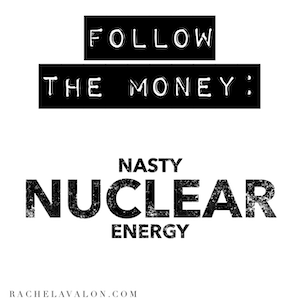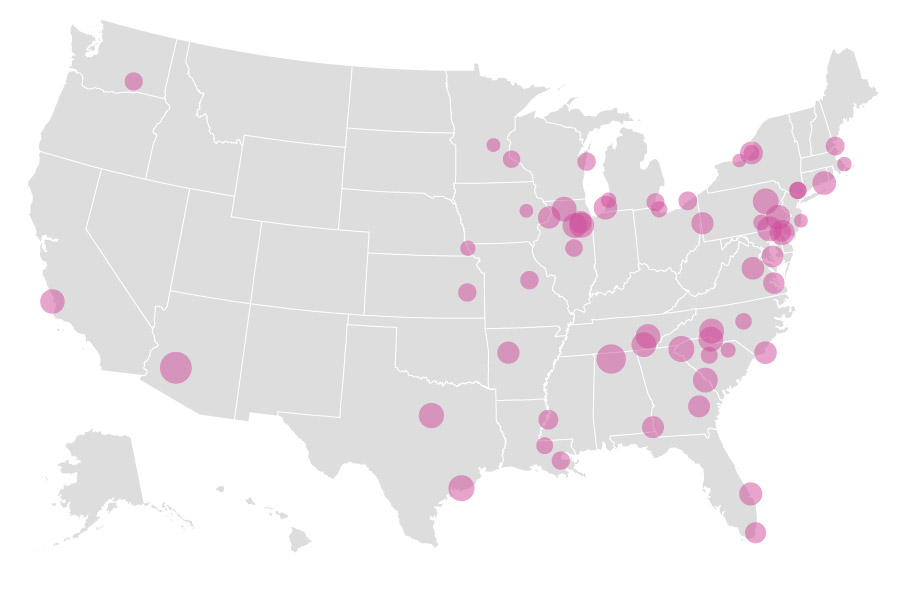Forget anything you’ve heard from financially backed politicians and industry proponents; the ins and outs of producing nuclear energy is known to be dangerous, dirty, and insanely expensive. Just follow the money…
 According to the Center for Responsive Politics, over $2 million was spent by Nuclear Energy Institute on lobbyists representing this special interest group. In fact, the only way nuclear energy is deemed viable at all is because U.S. taxpayers are being forced to cover large subsidies. Many consider it corporate welfare. Interestingly enough, private investors won’t even provide funding for nuclear power since it’s such a high-risk investment. Additionally, the Price-Anderson Act limits the liability of the energy corporations in case of a catastrophic accident, forcing taxpayers to cover the rest.[1] So, it’s a double insult. First, we have to help pay for nuclear power plants and second, we could be held partially responsible if something goes terribly wrong. According to the U.S. government, as of 2019, there are 59 commercially operating nuclear power plants in America.
According to the Center for Responsive Politics, over $2 million was spent by Nuclear Energy Institute on lobbyists representing this special interest group. In fact, the only way nuclear energy is deemed viable at all is because U.S. taxpayers are being forced to cover large subsidies. Many consider it corporate welfare. Interestingly enough, private investors won’t even provide funding for nuclear power since it’s such a high-risk investment. Additionally, the Price-Anderson Act limits the liability of the energy corporations in case of a catastrophic accident, forcing taxpayers to cover the rest.[1] So, it’s a double insult. First, we have to help pay for nuclear power plants and second, we could be held partially responsible if something goes terribly wrong. According to the U.S. government, as of 2019, there are 59 commercially operating nuclear power plants in America.

Source: The Washington Post – Mapping how the U.S. generates its electricity
The Invisible Danger of Nuclear Energy
Here’s the tricky part. Unlike oil spills and coal ash, which evoke heartbreaking imagery of birds covered in toxic black gunk or homes swept away, nasty, nuclear waste and its deadly radiation is the invisible threat among dirty energy sources. Perhaps that’s one reason it’s still slipped into conversations about truly sustainable energies such as wind and solar. The pollution is generally out of sight and out of mind (including the awful uranium mining and processing required for production or the radioactive, cancer-causing tritium that can end up in groundwater and our food supply.)[2] So, even though nuclear power produces lower emissions than fossil fuels, it’s time to cut through the confusion and the debate and take nuclear energy off the table.
Thankfully, the Physicians for Responsibility (a non-profit organization who was honored with a Nobel Peace Prize) has laid out every logical argument with why we need to abandon any plans to build new nuclear power plants. For example, as far as public and environmental risks go, each year 2,000 tons of high-level radioactive waste, plus 12 million cubic feet of low-level radioactive waste, is generated by the nuclear fuel process in the U.S.[3] Spent fuel is stored in cooling reactors, but there’s no permanent repository. That means that industry experts have no idea how future generations will protect themselves from it one hundred thousand years from now. Of course, we don’t have to focus on the future to consider the consequences of radioactive waste.
Painful Lessons from the Past
History has a lot to offer from the 1986 Chernobyl disaster, which continues to alter the lives of thousands of people and countless wildlife species in Ukraine, Russia, and Belarus. In addition to acknowledging the spiked rates of cancer that are still being tallied, look at the emotionally and physically painful deformities these children have been afflicted with due to radiation and other toxic exposure. Today, particularly in Belarus, children are still institutionalized because of the high rate of severe birth defects. Photographs can be viewed in a 2016 article published by Business Insider.
Imagine those children were your own. What would you feel? What would you do? Watching world leaders and corporations continue to peddle this frightening energy source makes me shake my head and keep my fingers crossed that history isn’t repeated in Fukushima (or closer to home.)
After all, the nuclear power plant disaster that occurred in Japan in 2011, following a major earthquake and tsunami, will likely take decades to be fully decommissioned. It took six years just to have robots be able to find the reactors’ melted uranium fuel. On top of that, Japan’s trade and industry ministry more than tripled its original estimate to $189 billion for compensating thousands of evacuees and addressing the daunting, radioactive, contamination threats.[4]
Clearly, the financial cost for this type of disaster is exorbitantly high, but it’s often unjust as well. Tepco, the nuclear plant’s operator, was supposed to be financially responsible. Some of the costs though have been passed onto residents through increased electricity bills. Once again, a private company is having the public help pay for their mess.
Meanwhile nearly 100 nuclear reactors are still operating in America, some of which are located near earthquake fault lines and identical in design to Unit One at Fukushima.[5]
How Nuclear Energy Jeopardizes National Security
Even if we somehow miraculously never had another catastrophic nuclear disaster, how can we support an industry that clearly jeopardizes our national security as well? After the substantial sacrifices we’ve made to reportedly help protect the American public from terrorism why would we keep relying on nuclear energy, which has an undeniable link to nuclear weapons? Let’s not forget that nuclear weapons programs in allied and non-allied countries such as North Korea, Pakistan, India, and France are due in part due to the nuclear power programs there. Considering that much of the uranium that’s used for U.S. facilities is transported from Russia or that various nuclear power plants here have been exposed for security vulnerabilities, we continue to run the risk of extremists getting their hands on it.
Switching to Sustainable Energy
Whether we look at energy from a health, environmental, or economic standpoint, real sustainable forms (such as wind and solar power) are the way to go. So, do your part in making the switch and we’ll all be able to sleep better at night.
Take Action
To shut down nuclear energy, here’s what you can do:
- Contact your representatives and demand that nuclear power plants in the U.S. are decommissioned (Germany made this commitment following the Fukushima disaster and are on track to have all of their nuclear power plants shut down by 2022)
- Demand more effective security measures are taken at existing nuclear power plants until they’re all closed
- Scale back on residential and commercial energy use
- Increase residential and commercial energy efficiency (who can you talk with about that?)
- Support 100% renewables by either signing up for green energy programs through your local utilities program, installing clean energy sources such as solar panels, solar tiles, or mini wind turbines, or request that your property owner does
- If you have an electric car or plug-in hybrid, make sure it’s charged through clean energy as much as possible (not electricity sourced from nuclear, coal, natural gas, or oil)
- Work to get money out of political campaigns (the nuclear energy industry is known to influence both republicans and democrats)
- Vote for political candidates who have the best track record for supporting renewables
- Host a movie night with friends and community members to watch the documentary, The Atomic States of America
- Help spread the word right now about nasty nuclear by sharing this article
My mission: As a Holistic Health Coach & Eco Expert, I’m dedicated to leading you straight to the core of what it takes to enjoy a new level of vitality, desired weight loss, sustainability, and detoxification. Enjoy my transformative programs and experience true health with true purpose!
[1] PeaceAndJusticeOnline.org. “Nuclear Power: Dangerous, Dirty & Expensive- 20 Key Facts.” May 19, 2011. Accessed October 7th, 2015. http://peaceandjusticeonline.org/2011/05/19/nuclear-power-dangerous-dirty-expensive-20-key-facts/
[2] PeaceAndJusticeOnline.org. “Nuclear Power: Dangerous, Dirty & Expensive- 20 Key Facts.” May 19, 2011. Accessed October 7th, 2015. http://peaceandjusticeonline.org/2011/05/19/nuclear-power-dangerous-dirty-expensive-20-key-facts/
[3] Physicians for Social Responsibility. PSR.org. “Dirty, Dangerous, and Expensive: The Truth About Nuclear Power.” Accessed October 7th, 2015. http://www.psr.org/resources/nuclear-power-factsheet.html
[4] TheGuardian.com “Dying robots and failing hope: Fukushima clean-up falters six years after tsunami” by Justin McCurry. March 8th, 2017. Accessed August 8th, 2019. https://www.theguardian.com/world/2017/mar/09/fukushima-nuclear-cleanup-falters-six-years-after-tsunami
[5] PeaceAndJusticeOnline.org. “Nuclear Power: Dangerous, Dirty & Expensive- 20 Key Facts.” May 19, 2011. Accessed October 7th, 2015. http://peaceandjusticeonline.org/2011/05/19/nuclear-power-dangerous-dirty-expensive-20-key-facts/
Leave a Reply